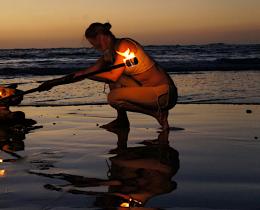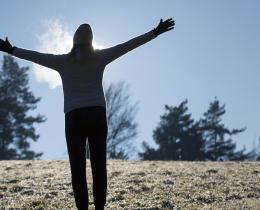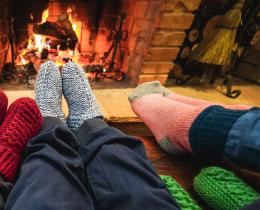1. Sneha—oiling the body, nose, and ears in the evening is nourishing and fortifying for the muscles and connective tissues. As our bodies are exposed to cold and wind, our pores and fascia tighten and roughen in response. Oiling the orifices of the head helps the sensory pathways stay balanced. Favor kapha massage oil, ashwagandha-bala oil, or sesame oil.
2. Do dry-brushing a few times a week to invigorate the tissues and move stagnant lymph and blood.
3. Shiroabhyanga—friction-rub the scalp to release dull, stagnant, heavy qualities of kapha in the head. Great to do in the morning.
4. Padabhyanga—oiling of the feet. Do this at night, using sesame or brahmi oil.
5. Good winter scents are rosemary, cinnamon, ginger, grapefruit, pine, bergamot, lemongrass, and rose geranium.
6. From the winter solstice onward, the winter season is the best time to sync with the sunrise (unless you are depleted and need to rest) and to honor going to bed after sunset.
7. Cultivate a warm place for practicing the flame of your inner and outer altar, carrying the warm colors of fire—red, orange, and ochre earth colors—in your home and dress (hats, scarves, and footwear) to keep the inner fire alive.
8. Follow the sun and begin to gradually increase your outward energy and activity so as to store energy (ojas) and at the same time keep your fire (tejas) and life-energy (prana) circulating. Be calm, joyous, positive, and inspired.
9. The winter season is the most vulnerable time for those with dim fire or (manda agni), kapha dosha, or those experiencing a stagnant lifestyle, depression, or lethargy due to less solar energy.
10. Cultivate a balance of solar and lunar yoga practices to balance the fire-keeping within your body. Solar practices with the New Year; waxing energy and lunar practices with the evening and waning energy.
11. Enjoy solar namaskars (sun salutations) and lunar namaskars (moon salutations). Build stamina in heating but grounding ways such as long standing-asana sequences, inversions (headstand, shoulderstand, handstand), and longer periods in backbends to keep the lungs and chest stimulated and heated (to prevent excess kapha or phlegm).
12. Honor lunar energy in earthy forward bends and hip openers to store energy for spring. Meanwhile, heating pranayama (yogic breathing) practices such as bhastrika can help lungs and sinuses stay strong and clear during cold and flu season, and these practices help release any excess kapha mucus from this area.



